Your wetsuit smells like a fish market, and you’re not sure how to clean wetsuits properly without ruining the neoprene material. Regular washing after each use removes sand, salt, and odors, which helps your wetsuit last longer and stay flexible.
This guide breaks down five simple steps that will keep your wetsuit fresh, clean, and ready for your next surf session or dive. You’ll save money and extend your wetsuit’s life with these easy care tips.
Key Takeaways
Rinse wetsuits immediately after use with cold fresh water to remove salt, sand, and debris that damage neoprene material.
Soak wetsuits for 30 minutes each side using mild baking soda or wetsuit shampoo for deep cleaning and odor removal.
Avoid harsh chemicals, hot water, and bleach as they break down neoprene adhesive and cause permanent material damage.
Hang wetsuits upside down by legs in shaded, ventilated areas to prevent water pooling and UV damage from sunlight.
Store completely dry wetsuits flat or folded in cool, dry places away from sharp objects, chemicals, and heat sources.
Table of Contents
How to Rinse Your Wetsuit
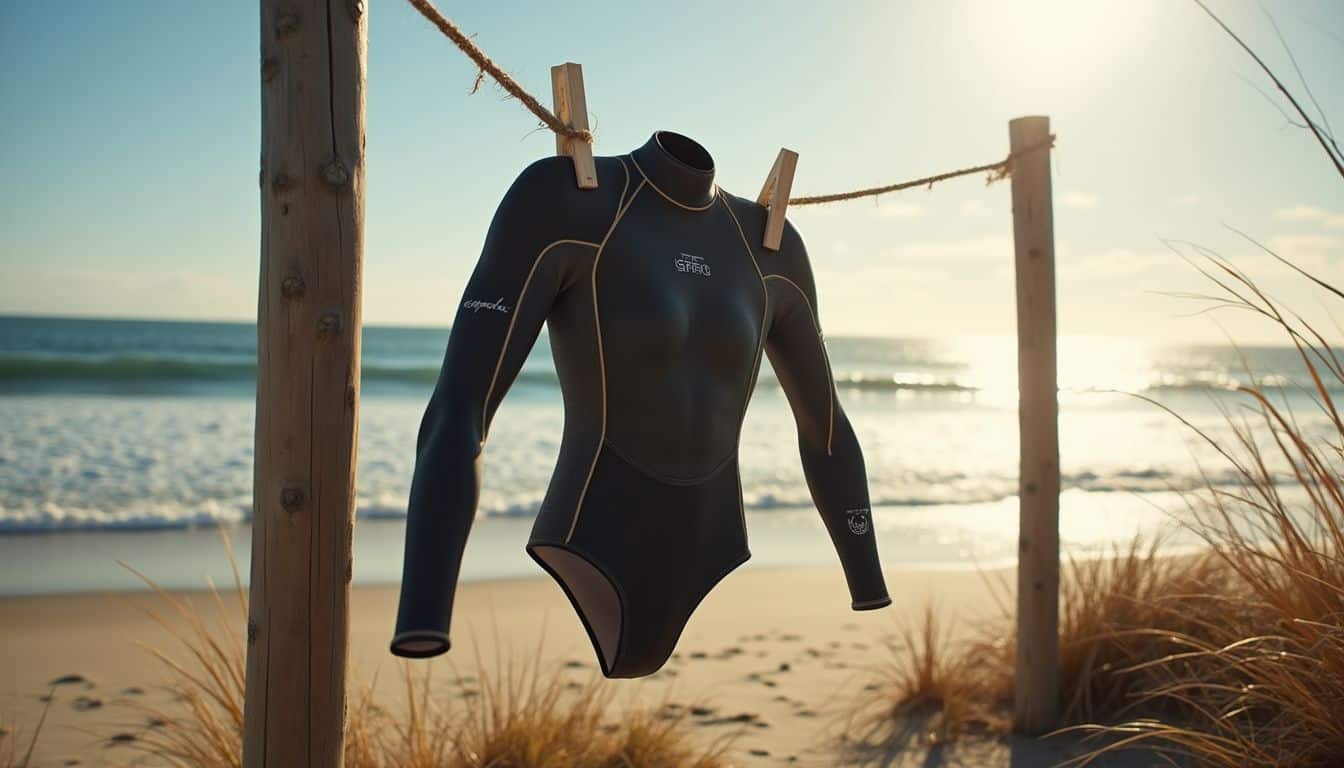
After every surf session, your wetsuit needs a thorough rinse to remove salt, sand, and other debris that can damage the neoprene material. This simple step prevents salt water damage and keeps your wetsuit flexible for years to come.
What is the best way to rinse a wetsuit after use?
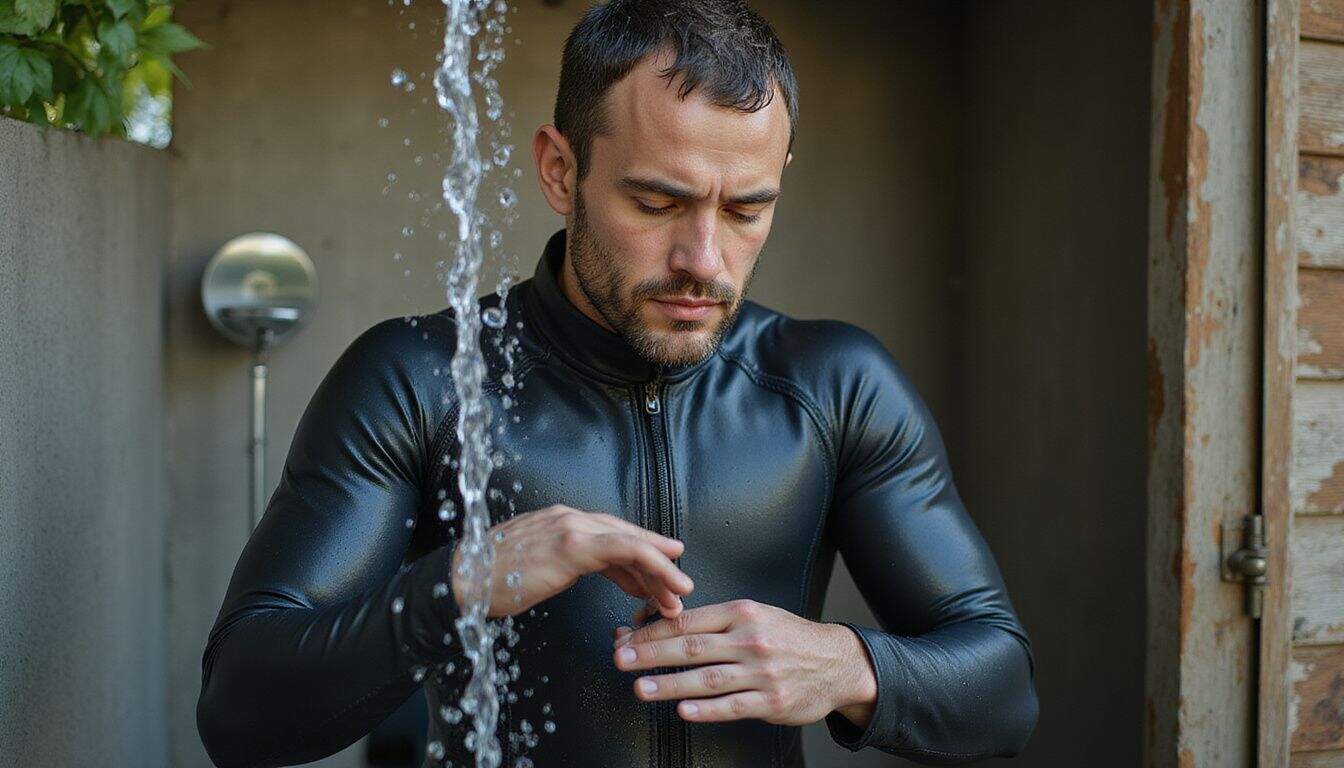
Fresh, cold water is your wetsuit’s best friend right after you leave the ocean. I learned this the hard way during my first surfing season, watching my gear deteriorate faster than it should have.
Rinse your wetsuit immediately in cold water to remove salt water damage and sand particles that can break down the neoprene material. Turn the wetsuit inside-out first, then rinse both sides thoroughly.
This simple step prevents salt crystals from forming and eating away at the fabric.
A well-rinsed wetsuit today means years of comfortable surfing tomorrow.
Pay special attention to the seams and zipper areas where salt and debris love to hide. Use your hands to gently work the fresh water through these spots, ensuring complete coverage.
Many surfers skip this crucial step, but proper rinsing extends your wetsuit lifespan significantly. Cold water protects the wetsuit flexibility while removing harmful residue that causes stiffness and cracking.
For those who don’t own gear yet, wetsuit rental services often provide pre-cleaned equipment.
The next step involves knowing exactly how to clean those tricky seams and zippers properly.
How do I clean seams and zippers properly?

Seams and zippers need special attention during wetsuit cleaning. Start by rinsing these areas with fresh water after each use. This simple step removes salt, sand, and debris that can damage your wetsuit over time.
Focus on the zipper track and seam lines where dirt loves to hide. I learned this lesson the hard way after my first wetsuit developed a sticky zipper from poor maintenance.
Operate the zipper while soaking to dislodge dirt trapped inside the mechanism. Move it up and down several times during your cleaning routine. Scrub zippers with a toothbrush for better cleaning results.
The bristles reach into small spaces that regular rinsing misses. Pay extra attention to the zipper pull and teeth, where salt buildup causes the most problems. This thorough approach keeps your wetsuit functioning properly for years of diving adventures.
Deep Cleaning Your Wetsuit
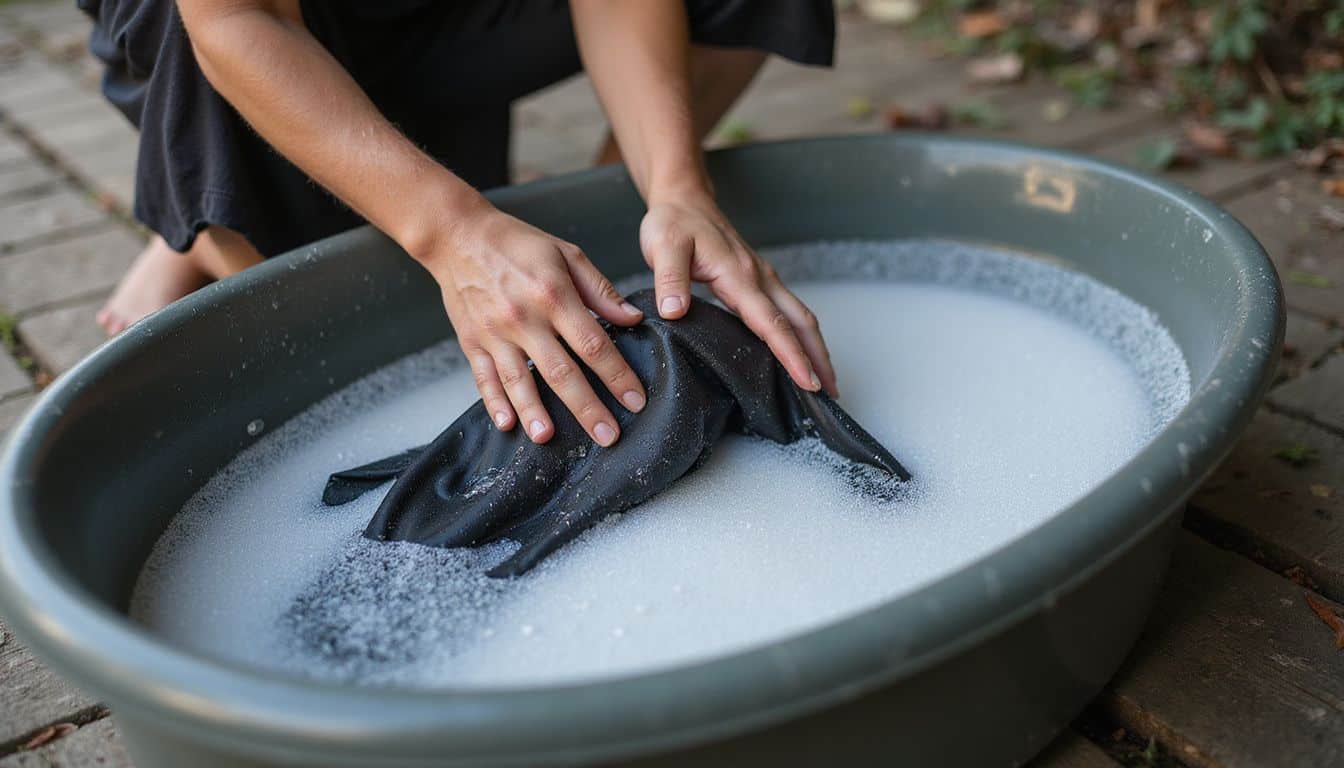
Sometimes your wetsuit needs more than a quick rinse to stay fresh and clean. Deep cleaning removes salt buildup, bacteria, and stubborn odors that regular rinsing can’t handle.
How do I soak my wetsuit for deep cleaning?
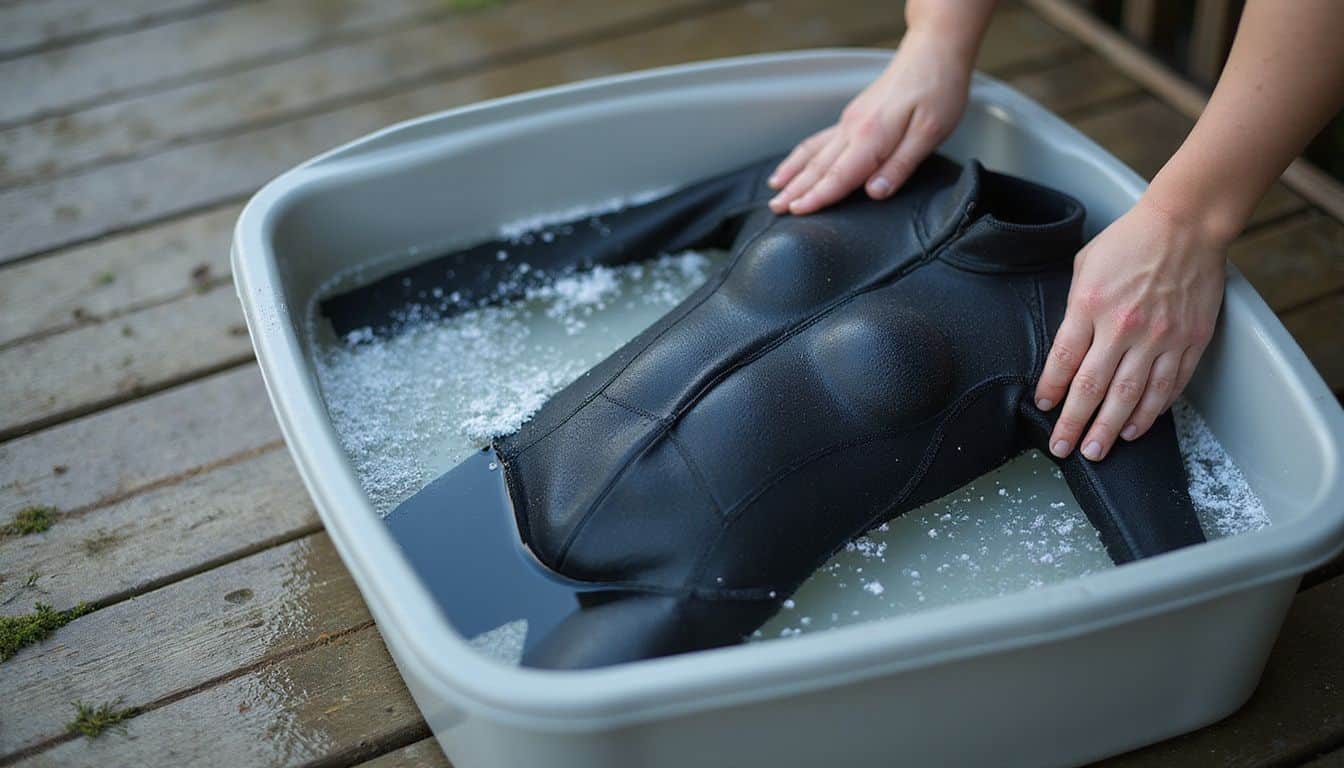
Fill a large tub or basin with cold or lukewarm freshwater. Add a mild solution of baking soda or wetsuit shampoo to create an effective cleaning mixture. Submerge your wetsuit completely in this solution, making sure all areas get covered.
Soak for approximately 30 minutes to allow the cleaning agents to penetrate the neoprene material.
A clean wetsuit is a happy wetsuit, and a happy wetsuit keeps you comfortable in the water.
After the first 30 minutes, flip the suit inside out and soak for another 30 minutes. This ensures both sides receive proper wetsuit care and attention. The extended soaking time helps break down salt deposits, oils, and bacteria that regular rinsing can’t remove.
Once the full hour is complete, rinse thoroughly with cool, fresh water to remove all cleaning residue. I’ve found this method works particularly well for removing stubborn odors and maintaining the suit’s flexibility.
Why should I avoid harsh chemicals and hot water on my wetsuit?

While soaking helps remove salt and grime, the temperature and cleaning products you choose make all the difference. Harsh chemicals can damage neoprene, impairing the wetsuit’s functionality and lifespan.
I learned this lesson the hard way after using bleach on my first wetsuit, which left the material stiff and cracked within weeks. Chemical cleaners break down the adhesive that holds seams together, causing your wet suit to fall apart faster than expected.
Hot water can lead to material deterioration, affecting the wetsuit’s fit and elasticity. Never use hot water, as it can damage neoprene fibers permanently. The heat causes the material to lose its stretch, making your wetsuit feel tight and uncomfortable.
Stick to cool water and gentle wetsuit deodorizer products instead. Your neoprene will thank you by lasting years longer and maintaining its flexibility for all your water adventures.
How to Remove Odors

Wetsuit odor removal requires specific solutions that won’t damage your gear’s delicate neoprene material. Commercial wetsuit cleaners work best, but you can also create effective mixtures using white vinegar or baking soda for stubborn smells.
What solutions effectively remove wetsuit odors?

Several proven solutions tackle stubborn wetsuit odor removal effectively. Wetsuit-specific shampoos contain specialized ingredients that eliminate bacteria responsible for unpleasant smells.
These products work better than regular soap because they target the specific microorganisms that thrive in neoprene materials. Vinegar solutions offer another powerful approach, mix one part vinegar with four parts water and soak your gear for 30 minutes.
This natural acid neutralizes odors at their source.
The key to odor-free wetsuits lies in understanding that bacteria, not just salt water, creates the smell.
Baking soda paste provides excellent results for stubborn problem areas. Create a thick mixture using baking soda and water, then apply it directly to booties, underarms, and other odor-prone zones.
Let the paste sit for 15 minutes before rinsing thoroughly. Commercial odor removers designed for neoprene also work well, though they cost more than homemade solutions. Avoid fabric softener and harsh chemicals, as these can damage the material and reduce your suit’s lifespan.
Proper Drying Techniques

Proper wetsuit drying makes the difference between gear that lasts years and gear that falls apart after a few seasons… and the way you hang your wetsuit can either protect your investment or destroy it faster than you think.
How should I hang my wetsuit to dry?
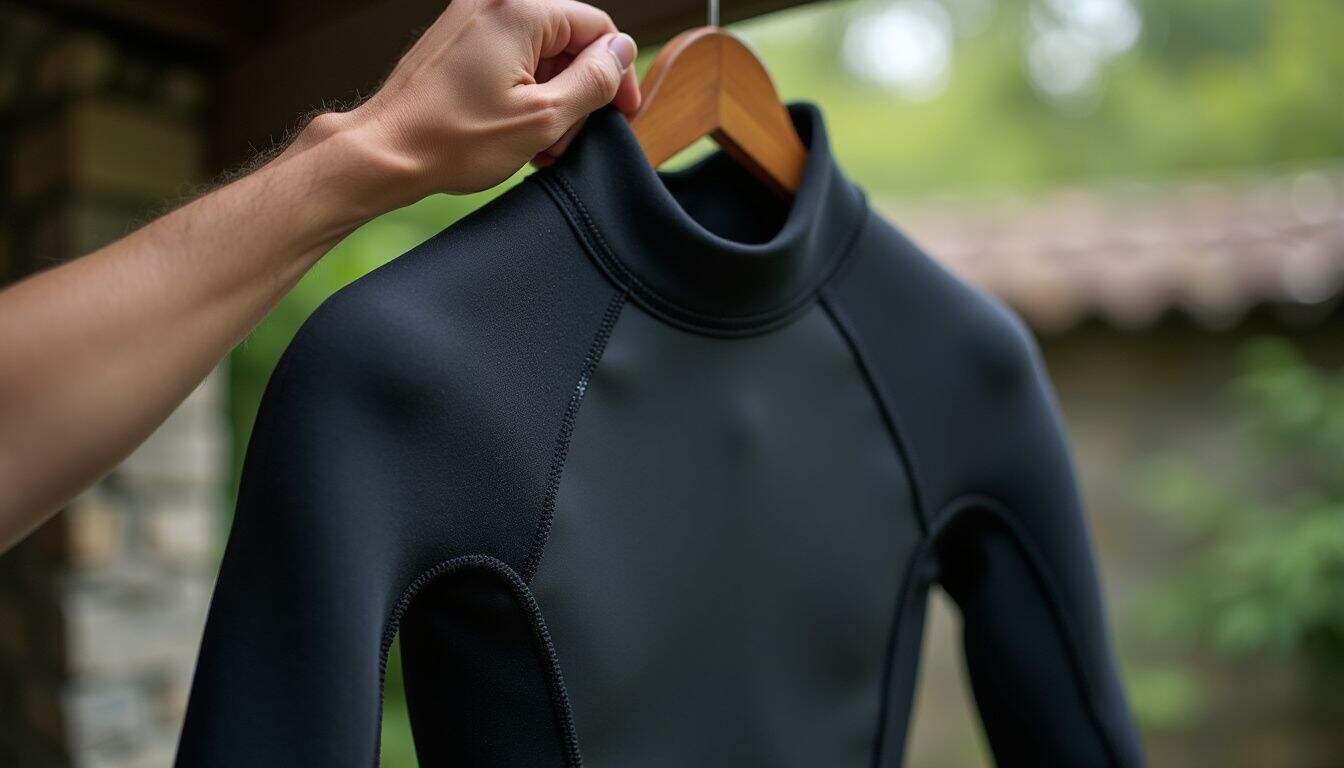
Hang your wetsuit upside down by the legs for the best drying results. This method prevents water from pooling in the shoulders and chest area, which can cause damage over time. I learned this technique after years of wetsuit maintenance, and it makes a huge difference in how quickly my gear dries.
Use a wide, padded wetsuit hanger to prevent shoulder stress and maintain the suit’s shape. Regular hangers can create pressure points that weaken the neoprene material and cause tears.
Good ventilation around the wetsuit speeds up the drying process significantly. Avoid direct sunlight because UV rays break down neoprene materials and cause them to crack or fade.
Find a shaded area with airflow, like a covered porch or garage with open doors. Turn the wetsuit inside out first, then flip it right-side out once the interior dries completely. This two-step process ensures both sides get proper air circulation and prevents moisture from getting trapped in the stitches.
Why should I avoid direct sunlight and dryers?

Direct sunlight accelerates neoprene wear and fades colors. UV rays cause neoprene to lose its stretch and become brittle. Your wetsuit’s material breaks down faster in bright sun, making it stiff and less flexible.
Heat from sunlight damages the contact cement that holds seams together. This weakens the sewn areas and can cause leaks. Colors fade quickly, turning your vibrant wetsuit into a dull shadow of its former self.
Dryers compromise material integrity and ruin your wetsuit completely. High heat melts neoprene, shrinks the fabric, and destroys the waterproof qualities you need. Machine drying also damages zippers and can separate seams permanently.
The tumbling action stretches and tears the delicate material. Your wetsuit becomes unwearable after just one trip through the dryer. Avoid hot water during cleaning for the same reasons, as heat causes similar damage whether from washing or drying.
Long-Term Storage Tips

Proper wetsuit storage keeps your gear in top shape for years… and there’s a specific way to fold, hang, and protect your suit that most people get wrong.
How should I store my wetsuit long-term?
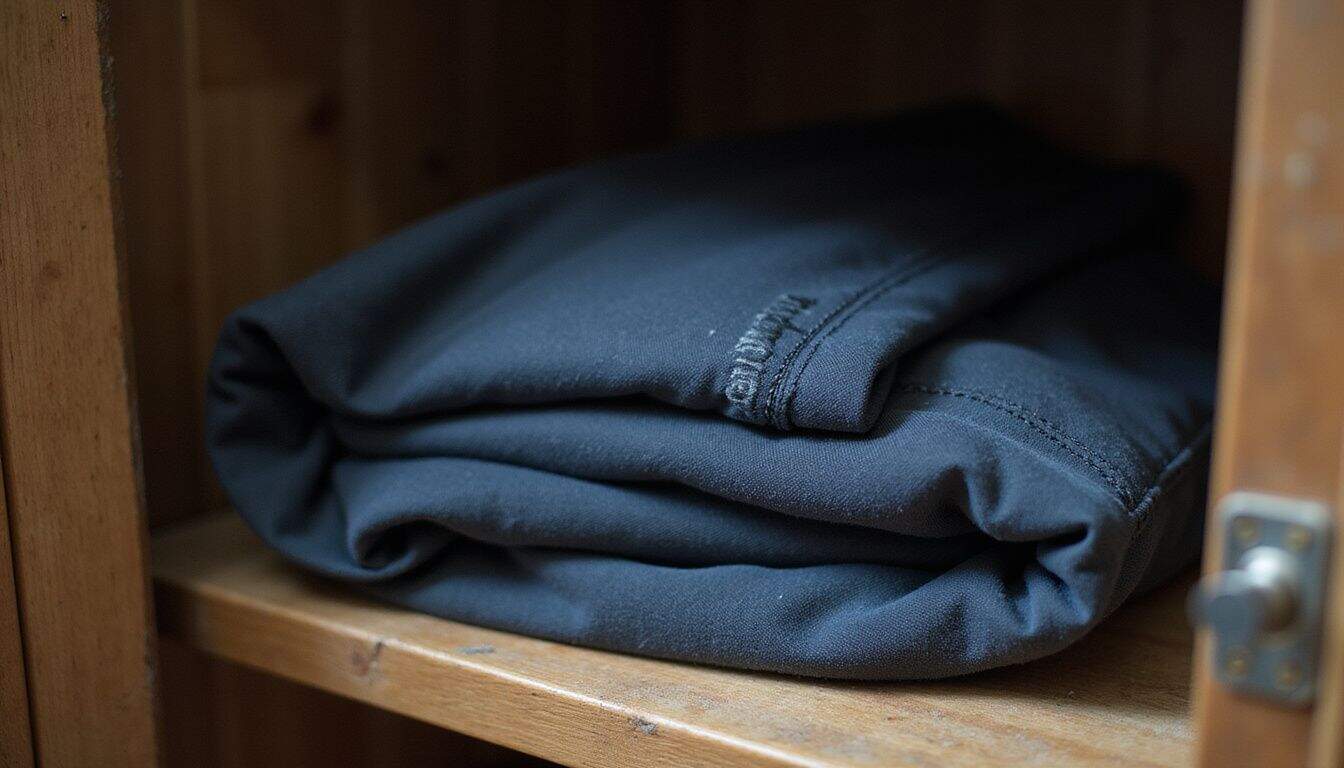
Store completely dry wetsuits in a cool, dry, and shaded area for long-term storage. Your wetsuit needs to be 100% dry before you put it away, or mold and odors will develop. Find a spot away from direct sunlight, heat sources, and areas with high humidity.
A closet shelf or storage bin works perfectly for wetsuit storage.
Fold your wetsuit carefully or lay it flat in your storage space. Avoid hanging it for months, as this can stretch the neoprene material. Keep your dry suit away from sharp objects, chemicals, and anything that might damage the fabric.
Check on your stored wetsuit every few months to make sure it stays in good condition and remains completely dry.
What should I keep away from when storing a wetsuit?

Now that you know the right storage position, certain items and conditions can damage your wetsuit during storage. Sharp objects like sewing needles, sandpaper, or tools can puncture the neoprene material and create holes that are difficult to repair.
Heat sources such as radiators, heaters, or hot water tanks can cause the material to crack and lose its flexibility.
Chemical products pose serious risks to your wetsuit’s integrity. Cleaning solvents, bleach, gasoline, and oil-based substances can break down the neoprene and weaken the seams. Direct sunlight streaming through windows can fade colors and make the material brittle over time.
Moths and other insects may chew through the fabric, so avoid storing your wetsuit in areas where pests are common. Keep your gear away from the washing machine area where detergent spills might occur, and never place heavy items on top of your wetsuit as this can create permanent creases that weaken the material.
How Will Wetsuit Care Change in 2025?

Wetsuit care will see exciting changes in 2025, with new eco-friendly cleaning products hitting the market. These biodegradable solutions will work better than traditional soaps while protecting both your gear and the ocean.
Smart technology will also transform how we maintain our wetsuits, with apps that remind you about proper laundry schedules and zipper care routines. Companies are developing specialized neoprene glue that repairs small tears instantly, making DIY fixes much easier for busy women who love water sports.
Advanced drysuits will feature self-cleaning materials that resist odors and bacteria naturally. Manufacturers are creating wetsuit storage systems with built-in humidity control, keeping your gear fresh for months.
The frequently asked questions sections on wetsuit websites will include AI-powered chatbots that give personalized care advice based on your specific model and usage patterns. Whether you’re planning a trip for swimming in the Bahamas or diving locally, these innovations will make wetsuit maintenance simpler and more effective than ever before.
People Also Ask
How often should I clean my wetsuit after use?
You should rinse your wetsuit with fresh water after every single use. This simple step prevents salt, sand, and bacteria from building up in the neoprene material.
What’s the best way to dry a wetsuit without damaging it?
Hang your wetsuit inside-out on a thick hanger, away from direct sunlight and heat sources. The UV rays and high temperatures can crack the neoprene and fade the colors permanently.
Can I use regular laundry detergent to wash my wetsuit?
Never use regular detergent, bleach, or fabric softener on your wetsuit. These harsh chemicals break down the neoprene and reduce the suit’s flexibility, warmth, and lifespan.
How do I remove stubborn odors from my wetsuit?
Soak the suit in cool water mixed with wetsuit-specific cleaner for 15-20 minutes, then rinse thoroughly. For persistent smells, you can also use a mixture of water and white vinegar as a natural deodorizer.
